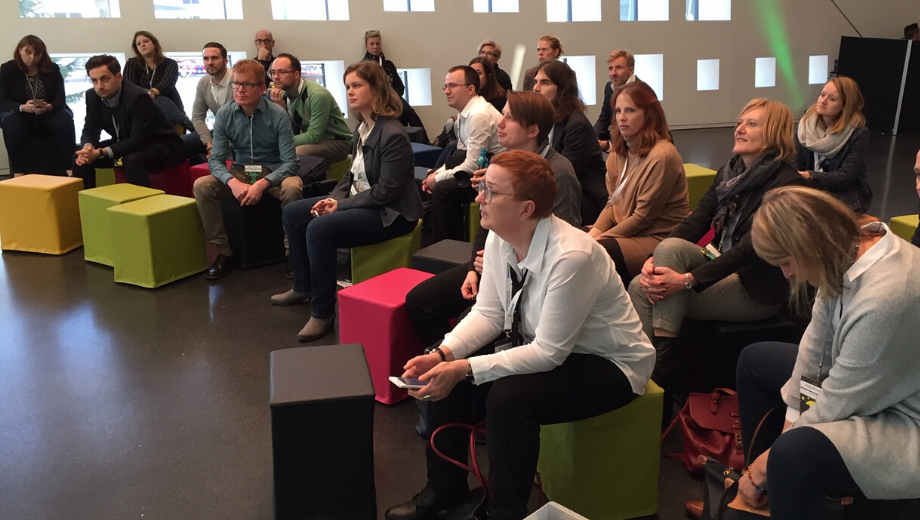Successful matchmaking at business events requires dramaturgy and suspense. The participants came up with great ideas at our workshop that was held in December!
On 4 December, around 150 event professionals met in Ingelheim at TechXperience 2018. Converve was one of the partners and a workshop provider. This allowed us to welcome an interested group of event designers to our “Development of creative match-making formats for events, trade fairs, and conferences” workshop.
In our interactions, several exciting aspects that event managers face time and time again were discussed – or aspects that they would like to see in the matchmaking at their events. This is reason enough for us to publish a review of the workshop here on our blog.
First finding: Successful marketing for match-making requires dramaturgy
Timing is everything in match-making. Suspense is required for match-making to reach its full potential at an event. This starts with the registration for the event and ranges from covering initial details (“There will be matchmaking at the event”, approx. 8 weeks prior to the event) to countdown (approx. 6 weeks prior to the event), the actual launch of the matchmaking event (approx. 4 weeks prior to the event), and a reminder (approx. 2 weeks prior to the event) about the event itself. These are the key milestones.
However, debriefing is no less important: Matchmaking allows you to establish and intensify relationships to valuable contacts, even after the trade fair – this means that the interaction extends beyond the physical event.
Second finding: Who can be matched with whom?
A common concern among many B2B organisers is that matchmaking will attract “free riders”, i.e. potential exhibitors who use the event in order to avoid the expenses of a stand and who are looking to establish direct contact with the visitors.
Therefore, “casting” matchmaking participants is important. There needs to be a selection process for participants of a matchmaking event. For example, matchmaking might only be offered to those who upload a type of applicationor who try to render the event a success in another way. This may require more effort. However, this does ensure higher quality.
It is not acceptable for VIP visitors to be spammed with contact requests. This means that the casting process needs to be able to consider power structures in a business to ensure that the participants that meet at the event are at the same “level of power”.
Third finding: Taking monetisation into account from the very beginning
In order to trigger a discussion in this area in particular, we made the bold suggestion that trade-fair visitors are willing to spend more money to participate in an event if efficient B2B match-making is offered. If need be, even without their own stand at the trade fair!
This, of course, is a way of thinking that is still strange to many trade-fair managers. After all, the lion’s share of their income is derived from renting out square metres.

Event designers discussing successful matchmaking at B2B events in Ingelheim
However, in the framework of the group discussion, many suggestions were in fact made as to how matchmaking can contribute to monetization. For example, exhibitors could pay per lead/match. Entry models could be offered (participation in a match-making area rather than a stall), match-making tables could be sponsored, search results in matchmaking for participants could be monetized by means of ads.
In any case, it is crucial that organizers of B2B events think about how to turn their matchmaking service into a business model.
Forth finding: Why not try gamification?
The communication with participants prior to the event must be well-planned for matchmaking to be a success; a perfect client experience is key: easy exchange of contact details, high-quality meetings, and better planning of the attendance of the event are aspects of interest to the participants.
To make all this fun, some of the participants in our workshops came up with the idea of integrating gamification elements: Who has the highest number of quality meetings? Who is the main contributor to the event by spreading additional links or information and by being particularly active on social-media platforms etc.?
Conclusion
For us at Converve, it was incredibly exciting to examine the aspects of successful matchmaking at this workshop in a direct exchange of ideas with the organizers. The general consensus among participants was that matchmaking is actually a lot of work. However, it is worth the effort since all the participants at a B2B event work more efficiently, achieve better results, and can better justify their expenses. Some event organizers are creating new positions for this very purpose, such as that of a “Matchmaking Manager”.
By the way: In this contribution, we have summarized 18 success factors for fruitful match-making at your B2B events.



